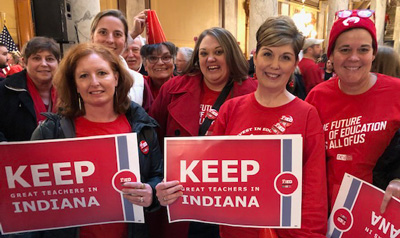Submitted
Hamilton Heights School Corporation was well-represented at the “Red for Ed” rally at the Indiana Statehouse last month. The Heights representatives were among over 1,000 people, mostly educators, who joined colleagues from districts around the state to advocate for increased teacher pay and funding for our public schools.
Heights was represented by seven teachers, two school board members, and its superintendent, who are deeply passionate about improving teacher compensation, funding of public schools and advancing the teaching profession. It is their hope that their passion was seen and felt by lawmakers.
The rally was hosted and organized by the Indiana State Teachers Association (ISTA), the state’s largest teachers’ union with over 40,000 members.

Heights’ educators, administrators and board members went “Red for Ed” at the statehouse on March 9 with kids at the heart of their effort to advocate for better compensation and more funding for public education in Indiana. (From left) Julie Davis, Connie Kolb, Liz Douglas, Arnett Cooper, Patty Lefkowicz, Kara Doenges, Jennifer Luce and Kim Arrowood (Noblesville Schools). (Photo provided)
Currently, legislators are in the second half of the 2019 budget session. House Republicans have proposed a roughly 2 percent increase for K-12 education. However, there is nothing within this budget specifically earmarked for teachers. The major concern is that if the budget passes as is some Indiana schools could be negatively impacted and would have to make cuts in some areas – cuts that many schools can’t afford to make.
ISTA has been meeting with legislative leaders in the House and the governor’s office since the summer on increased education funding, with teacher pay being a priority. When discussions did not yield progress on the topic, the rally was organized to send a strong message to legislators, help inform the public of what is happening in the area of school funding and build solidarity with fellow teachers throughout the state.
“It’s time that we get very, very serious about this,” said ISTA President Teresa Meredith. “[State lawmakers are] headed in the right direction, but we need them to come much closer and really hear, understand and demonstrate respect for their concern for the profession through putting some more money in that budget for public education and marking some of it for teacher pay.”
Jennifer Luce, Hamilton Heights Middle School sixth grade English and Reading teacher and HHCTA President, agrees: “We have reached a critical point in K-12 public education. To continue to give our students the best chance to learn and succeed, regardless of where they live, we need to ensure we can hire and retain the best educators and offer the best opportunities in curriculum and the classroom. Compensation and funding are essential components to these goals.”
Education reforms over the years have made it more difficult to be a teacher as well as made it more difficult to attract and retain good teachers across the state. There have been some changes at the state level that have negatively impacted the teaching profession, including reducing collective bargaining rights, teacher pay scales, incentives for advanced degrees and seniority rights to name a few.
“It is our hope to generate more support for public schools and reach out to our fellow educators, parents and public-school advocates to help increase teacher pay and funding for our public schools,” said Meredith. “We need our legislators to make public education a priority through fair compensation and funding to help us.”
“While the ISTA will continue to work with lawmakers, we wanted to reach out to our district to let them know they can help by calling, writing, or emailing their legislator,” said Luce.
Click here to stay up to date on the topic and for more information.
Another rally in support of public education will take place at 3 p.m. on Tuesday, April 16 at the Indiana Statehouse.
According to data provided by the ISTA:
- 72 percent of Hoosier say public school teachers in Indiana are paid too little.
- 7 in 10 say public schools need more funding.
- Investment in attracting and retaining quality teachers is a top priority for Hoosiers.
- More than 8 in 10 want to see funding go to classroom instruction rather than administration.
- On average, Hoosier educators are paid less than educators in surrounding states.
- Hoosier educators spend a lower proportion of funds in the classroom than other states. The impact is out-of-date textbooks, the elimination of programs like art and music, increased class sizes and even laying off teachers.
- Any funding increase below 3 percent is simply not enough for our students or educators.
